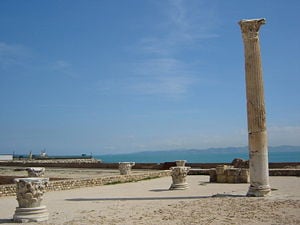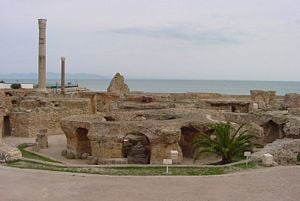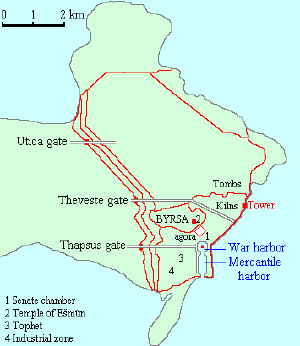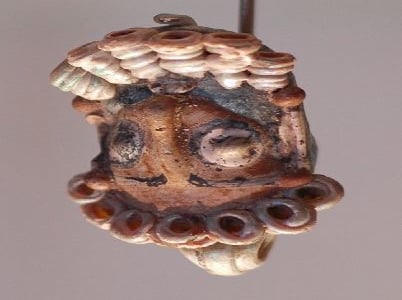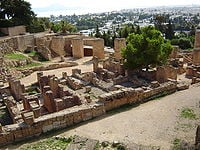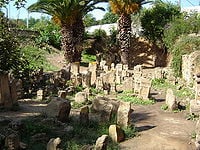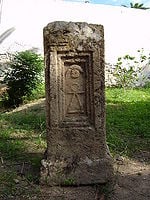Carthage
The term Carthage refers both to an ancient city in North Africa—located on the eastern side of Lake Tunis across from the center of modern Tunis in Tunisia—and to the civilization which developed within the city's sphere of influence, in much the same way "Rome" can refer to Rome the city or the ancient civilization.
Originally a settlement of Phoenician colonists, Carthage grew into a vast economic power throughout the Mediterranean, accumulating wealth and influence through its economic prowess. Carthage was a contemporary superpower with the Roman Republic of the second and third century B.C.E., and was its rival for dominance of the western Mediterranean. Eventually this rivalry led to a series of wars known as the Punic Wars, in which a series of losses led to a decline in Carthage's political and economic strength, mostly due to the harsh penalties imposed on Carthage by Rome as conditions of the cessation of hostilities. The third and final Punic war ended with the complete destruction of the city of Carthage and the annexation of the last remnants of Carthaginian territory by Rome. Although a distinct Carthaginian civilization ceased to exist, remnants of it contributed to later Mediterranean culture.
The name Carthage is derived by way of Greek and Latin from the Phoenician (QRT HDST) meaning "new city." More than one Phoenician settlement originally bore this name, although only one city has the distinction of being the Carthage of the ancient world.
While the term Carthaginian is used by many modern writers, many ancient writings used the adjective Punic to describe anything to do with Carthaginian civilization, because of the Latin term Punius (earlier Poenius), itself borrowed from Greek Φοινικη, "Phoenician."
History
The historical study of Carthage is problematic. Due to the subjection of the civilization by the Romans at the end of the Third Punic War, very few Carthaginian historical primary sources survive. There are a few ancient translations of Punic texts into Greek and Latin, as well as inscriptions on monuments and buildings discovered in North Africa.[1] However, the majority of available primary source material about Carthaginian civilization was written by Greek and Roman historians, such as Livy, Polybius, Appian, Cornelius Nepos, Silius Italicus, Plutarch, Dio Cassius, and Herodotus.
These authors were members of cultures which were nearly always in competition, and often in conflict, with Carthage. The Greeks contested with Carthage for Sicily,[2] for instance, and the Romans fought the Punic Wars against Carthage.[3] Inevitably the accounts of Carthage written by outsiders include significant bias.
Recent excavation of ancient Carthaginian sites has brought much more primary material to light. Some of these finds contradict or confirm aspects of the traditional picture of Carthage, but much of the material is still ambiguous.
Founding of Carthage
Carthage was founded in 814 B.C.E. by Phoenician settlers from the city of Tyre, bringing with them the city-god Melqart. According to tradition, the city was founded by Queen Dido (or Elissa or Elissar) who fled Tyre following the murder of her husband in an attempt by her younger brother to bolster his own power. A number of foundation myths have survived through Greek and Roman literature.
In 509 B.C.E. a treaty was signed between Carthage and Rome indicating a division of influence and commercial activities. This is the first known source indicating that Carthage had gained control over Sicily and Sardinia.
By the beginning of the fifth century B.C.E., Carthage had become the commercial center of the West Mediterranean region, a position it retained until overthrown by the Roman Republic. The city had conquered most of the old Phoenician colonies such as Hadrumetum, Utica and Kerkouane, subjugated the Libyan tribes, and taken control of the entire North African coast from modern Morocco to the borders of Egypt. Its influence also extended into the Mediterranean, taking control over Sardinia, Malta, the Balearic Islands, and the western half of Sicily. Important colonies had also been established on the Iberian peninsula.
Legends
Queen Elissar
Queen Elissar (also known as "Alissa," and by the Arabic name اليسار also اليسا and عليسا) was the princess of Tyre who founded Carthage. At its peak her metropolis came to be called a "shining city," ruling 300 other cities around the western Mediterranean and leading the Phoenician Punic world.
Elissar was the Princess of Tyre. Her brother, King Pygmalion of Tyre, murdered her husband, the high priest. Elissar escaped the tyranny of her own country and founded Carthage and subsequently its later dominions. Details of her life are ambiguous, but the following can be deduced from various sources. According to Justin, Princess Elissar was the daughter of King Matten of Tyre (also known as Muttoial or Belus II). When he died, the throne was jointly bequeathed to her and her brother, Pygmalion. She married her uncle Acherbas (also known as Sychaeus) High Priest of Melqart, a man with both authority and wealth comparable to the king. Pygmalion was a tyrant, lover of both gold and intrigue, and desired the authority and fortune enjoyed by Acherbas. Pygmalion assassinated Acherbas in the temple and managed to keep the misdeed concealed from his sister for a long time, deceiving her with lies about her husband's death. At the same time, the people of Tyre called for a single sovereign, causing dissent within the royal family.
Queen Dido
In the Aeneid, Queen Dido, Virgil's name for Queen Elissar of Greek legend, is first introduced as a well respected character. In just seven years since their exodus from Tyre, the Carthaginians have rebuilt a successful kingdom under her rule. She is perceived as even more noble when she offers asylum to Aeneas and his men, who have recently escaped from Troy. However, Aeneas is reminded by the messenger god, Mercury, that his mission is not to stay in Carthage with his new-found love, Dido, but to travel to Italy to found Rome. When Aeneas leaves her, heart-broken Dido orders a pyre to be built where she falls upon Aeneas' sword. It is on this pyre that Dido has a vision of the future Carthaginian general, Hannibal, avenging her.
Phoenician Colonization
Carthage was one of a number of Phoenician settlements in the western Mediterranean. In the tenth century B.C.E., the eastern Mediterranean shore was inhabited by various Semitic-speaking populations. The people inhabiting what is now Lebanon called their language Canaanite, but were referred to as Phoenicians by the Greeks. The Phoenician language was very close to ancient Hebrew, to such a degree that the latter is often used as an aide in translation of Phoenician inscriptions.
The Phoenician cities were highly dependent on trade, and included a number of major ports in the area. The Phoenicians' leading city was Tyre, which established a number of trading posts around the Mediterranean. Carthage and a number of other settlements later evolved into cities in their own right.
Extent Of Phoenician settlement
In order to provide a resting place for merchant fleets, to maintain a Phoenician monopoly on an area's natural resource, or to conduct trade on its own, the Phoenicians established numerous colonial cities along the coasts of the Mediterranean. They were stimulated to found their cities by a need for revitalizing trade in order to pay the tribute extracted from Tyre, Sidon, and Byblos by the succession of empires that ruled them and by fear of complete Greek colonization of that part of the Mediterranean suitable for commerce. The Phoenicians lacked the population and need to establish self-sustaining cities abroad, and most cities had less than 1,000 inhabitants, but Carthage and a few other cities developed into huge metropolises.
Some 300 colonies were established in Tunisia, Morocco, Algeria, Iberia, and to a much lesser extent, on the arid coast of Libya. The Phoenicians controlled both Cyprus, Sardinia, Corsica, and the Balearic Islands, and also minor possessions in Crete and Sicily; the latter settlements being in perpetual conflict with the Greeks. The Phoenicians managed to control all of Sicily for a limited time. The entire area later came under the leadership and protection of Carthage, which in turn dispatched its own colonists to found new cities or to reinforce those that declined with Tyre and Sidon.
The first colonies were made on the two paths to Iberia's mineral wealth—along the African coast and on Sicily, Sardinia, and the Balearic Islands. The center of the Phoenician world was Tyre, serving as an economic and political hub. The power of this city waned following numerous sieges and its eventual destruction by Alexander the Great, so the role of leader passed to Sidon, and eventually to Carthage. Each colony paid tribute to either Tyre or Sidon, but neither had actual control of the colonies. This changed with the rise of Carthage, since the Carthageans appointed their own magistrates to rule the towns and Carthage retained much direct control over the colonies. This policy resulted in a number of Iberian towns siding with the Romans during the Punic Wars.
Life in Carthage
Language
Carthaginians spoke Punic, a dialect of Phoenician.
Topography
Carthage was built on a promontory with inlets to the sea to the north and south. The city's location made it master of the Mediterranean maritime trade. All ships crossing the sea had to pass between Sicily and the coast of Tunisia, where Carthage was built, affording it great power and influence.
Two large, artificial harbors were built within the city, one for harboring the city's massive navy of 220 warships and the other for mercantile trade. A walled tower overlooked both harbors.
The city had massive walls, 23 miles in length and longer than the walls of comparable cities. Most of the walls were located on the shore, and Carthaginian control of the sea made attack from that avenue difficult. The two and a half to three miles of wall on the isthmus to the west were truly gargantuan and, in fact, were never penetrated.
The city had a massive necropolis, religious area, market places, council house, towers, and a theater, and was divided into four equally-sized residential areas with the same layout. Roughly in the middle of the city stood a high citadel called the Byrsa. It was one of the largest cities in Hellenistic times (by some estimates, only Alexandria was larger) and was among the largest cities in pre-industrial history.
Commerce
The empire of Carthage depended heavily on its trade with Tartessos and other cities of the Iberian peninsula, from which it obtained vast quantities of silver, lead, and, even more importantly, tin ore, which was essential to the manufacture of bronze objects by the civilizations of antiquity. Its trade relations with the Iberians and the naval might that enforced Carthage's monopoly on trade with tin-rich Britain and the Canary Islands allowed it to be the sole significant broker of tin and maker of bronze. Maintaining this monopoly was one of the major sources of power and prosperity for Carthage, and a Carthaginian merchant would rather crash his ship upon the rocky shores of Britain than reveal to any rival how it could be safely approached. In addition to being the sole significant distributor of tin, its central location in the Mediterranean and control of the waters between Sicily and Tunisia allowed it to control the eastern nations' supply of tin. Carthage was also the Mediterranean's largest producer of silver, mined in Iberia and the North African coast, and, after the tin monopoly, this was one of its most profitable trades. It has been suggested that either the Carthaginians or the Phoenicians of cities such as Tyre or Byblos may have mined gold in Zimbabwe.
Carthage's economy began as an extension of that of its parent city, Tyre. Its massive merchant fleet traversed the trade routes mapped out by Tyre, and Carthage inherited from Tyre the art of making the extremely valuable dye Tyrian Purple. It was one of the most highly-valued commodities in the ancient Mediterranean, being worth fifteen to twenty times its weight in gold. High Roman officials could only afford togas with a small stripe of it. Carthage also produced a less-valuable crimson pigment from the cochineal.
Carthage produced finely embroidered and dyed textiles of cotton, linen, wool, and silk, artistic and functional pottery, faience, incense, and perfumes. It worked with glass, wood, alabaster, ivory, bronze, brass, lead, gold, silver, and precious stones to create a wide array of goods, including mirrors, highly-admired furniture and cabinetry, beds, bedding, and pillows, jewelry, arms, implements, and household items. It traded in salted Atlantic fish and fish sauce, and brokered the manufactured, agricultural, and natural products of most every Mediterranean people.
In addition to manufacturing, Carthage practiced highly advanced and productive agriculture, using iron plows (which were only implemented in Early Modern Europe during the 1600s), irrigation, and crop rotation. Mago wrote a famous treatise on agriculture which the Romans ordered translated after Carthage was captured. After the Second Punic War, Hannibal promoted agriculture to help restore Carthage's economy and pay the war indemnity to Rome, and he was largely successful.
Carthage produced wine, which was highly prized in Rome, Etrusca, and Greece. Rome was a major consumer of raisin wine, a Carthaginian specialty. Fruits, nuts, grain, grapes, dates, and olives were grown, and olive oil was exported in competition with Greece. Carthage also raised fine horses, similar to contemporary Arabian horses, which were greatly prized and exported.
Carthage's merchant ships, which surpassed even those of the cities of the Levant, visited every major port of the Mediterranean, Britain, the coast of Africa, and the Canary Islands. These ships were able to carry over 100 tons of goods. The commercial fleet of Carthage was comparable in size and tonnage to the fleets of major European powers in the eighteenth century.
Merchants at first favored the ports of the east: Egypt, the Levant, Greece, Cyprus, and Asia Minor. But after Carthage's control of Sicily brought it into conflict with Greek colonists, it established commercial relations in the western Mediterranean, including trade with the Etruscans.
Carthage also sent caravans into the interior of Africa and Persia. It traded its manufactured and agricultural goods to the coastal and interior peoples of Africa for salt, gold, timber, ivory, ebony, and skins and hides. Its merchants invented the practice of sale by auction and used it to trade with the African tribes. In other ports, they tried to establish permanent warehouses or sell their goods in open-air markets. They obtained amber from Scandinavia and tin from the Canary Islands. From the Celtiberians, Gauls, and Celts, they obtained amber, tin, silver, and furs. Sardinia and Corsica produced gold and silver for Carthage, and Phoenician settlements on islands such as Malta and the Balearic Islands produced commodities that would be sent back to Carthage for large-scale distribution. Carthage supplied poorer civilizations with simple things, such as pottery, metallic products, and ornamentations, often displacing the local manufacturing, but brought its best works to wealthier ones such as the Greeks and Etruscans. Carthage traded in almost every commodity wanted by the ancient world, including spices from Arabia, Africa, and India, and slaves.
These trade ships went all the way down the Atlantic coast of Africa to Senegal and Nigeria. One account has a Carthaginian trading vessel exploring Nigeria, including identification of distinguishing geographic features such as a coastal volcano and an encounter with gorillas (See Hanno the Navigator). Irregular trade exchanges occurred as far west as Madeira and the Canary Islands, and as far south as southern Africa. Carthage also traded with India by traveling through the Red Sea and the perhaps-mythical lands of Ophir and Punt, which may be present-day Somalia.
Archaeological finds show evidence of all kinds of exchanges, from the vast quantities of tin needed for a bronze-based metals civilization to all manner of textiles, ceramics, and fine metalwork. Before and in between the wars Carthaginian merchants were in every port in the Mediterranean, buying and selling, establishing warehouses where they could, or just bargaining in open-air markets after getting off their ship.
The Etruscan language has not yet been deciphered, but archaeological excavations of Etruscan cities show that the Etruscan civilization was for several centuries a customer and a vendor to Carthage, long before the rise of Rome. The Etruscan city-states were, at times, both commercial partners of Carthage as well as military allies.
Government
Carthage, like every other Phoenician city, was first governed by Kings.
Later, it became an oligarchy. Punic inscriptions show that its heads of state were called SPΘM /ʃuftˤim/, meaning "judges." SPΘ /ʃufitˤ/ might originally have been the title of the city's governor, installed by the mother city of Tyre. Later, two judges were elected annually from among the most wealthy and influential families. This practice descended from the plutocratic oligarchies that limited the King's power in the first Phoenician cities. These aristocratic families were represented in a supreme council that had a wide range of powers. However, it is not known whether the judges were elected by this council or by an assembly of the people. Judges appear to have exercised judicial and executive power, but not military. Although the city's administration was firmly controlled by oligarchs, democratic elements were to be found as well: Carthage had elected legislators, trade unions, and town meetings. Polybius, in his History book 6, said that the Carthaginian public held more sway over the government than the people of Rome held over theirs. There was a system of checks and balances, as well as public accountability.
The Carthaginians appointed professional generals and admirals, who were separate from the civil government. The Tribes voted and appointed an agent to represent them in a governing council. There was also a council of elders with fairly strong powers but only as an advisory role to the younger council. There was also an assembly of nobles.
Eratosthenes, head of the Greek library of Alexandria, noted that the Greeks had been wrong to describe all non-Greeks as barbarians, since the Carthaginians as well as the Romans had a constitution. Aristotle also knew and wrote about the Carthaginian constitution in his Politics (Book II, Chapter 11).
During the period between the end of the First Punic War and the end of the Second Punic War, Carthage was ruled mainly by members of the Barcid family, who were given control of the Carthaginian military and all the Carthaginian territories outside of Africa.
The navy of Carthage was the city's primary security, and it was the preeminent force patrolling the Mediterranean in Carthage's golden age. This was due to its central location, control of the pathway between Sicily and Tunisia—through which all ships had to travel in order to cross the Mediterranean—and the skill with which its ships were designed and built.
Originally based on Tyrian designs with two or three levels of rowers that were perfected by generations of Phoenician seamanship, it also included quadriremes and quentiremes, warships with four and five levels for rowers, respectively. This advance in design was never achieved by the Lebanese Phoenicians.
A large part of the sailors on the fleet were recruited from the lower class citizenry, as the navy offered a profession and financial security. This helped to contribute to the city's political stability, since the unemployed, debt ridden poor in other cities were frequently inclined to support revolutionary leaders in the hope of improving their own lot.[4]
The Carthaginian navy included some 300 warships that continuously patrolled the expanse of the Mediterranean and held the Straits of Gibraltar against any foreign ship. It was once remarked that the Mediterranean was a Phoenician lake and no man dared to wash his hands in it without Carthaginian permission.
Polybius wrote in the sixth book of his History that the Carthaginians were, "more exercised in maritime affairs than any other people." The Romans, unable to defeat them through conventional maritime tactics, were forced to simply board the ships and fight in hand to hand combat.
Religion
Carthaginian religion was based on Phoenician religion. Phoenician religion was inspired by the powers and processes of nature. Many of the gods they worshiped, however, were localized and are now known only under their local names. A pantheon was presided over by the father of the gods, but a goddess was the principal figure in the Phoenician pantheon.
Pantheon
The supreme divine couple was that of Tanit and Ba'al Hammon. The goddess Astarte seems to have been popular in early times. At the height of its cosmopolitan era, Carthage hosted a large array of divinities from the neighboring civilizations of Greece, Egypt, and the Etruscan city-states.
Caste of priests and acolytes
Surviving Punic texts are detailed enough to give a portrait of a very well organized caste of temple priests and acolytes performing different types of functions, for a variety of prices. Priests were clean shaven, unlike most of the population. In the first centuries of the city, ritual celebrations included rhythmic dancing, derived from Phoenician traditions.
Punic stelae
The sacred precinct of Carthage, now called the Tophet, after a Biblical term, was the location of the temple of the goddess Tanit and the necropolis. Cippi and stelae of limestone are characteristic monuments of Punic art and religion, and are found throughout the western Phoenician world in unbroken continuity, both historically and geographically. Most of them were set up over urns containing cremated human remains, placed within open-air sanctuaries. Such sanctuaries constitute striking relics of Punic civilization.
Child sacrifice
It is a matter of dispute whether the Carthaginians practiced child sacrifice. Plutarch (ca. 46–120 C.E.) mentions the practice, as do Tertullian, Orosius, and Diodorus Siculus. Livy and Polybius do not. The Hebrew Bible also mentions child sacrifice practiced by the Caananites, ancestors of the Carthaginians, and by some Israelites.
Modern archaeology in formerly Punic areas has found cemeteries for children and infants, including the famous "Tophet," which can be translated "place of burning." Some scholars suggested that this was the location of frequent child sacrifice.[5] However, it is possible that reports of child sacrifice were based on a misconception, later used as blood libel by the Romans who destroyed the city. The Tophet may simply have been used as graves for stillborn infants or children who died very early.[6]
Carthaginian ethnicity and citizenship
In Carthaginian society, advancement was largely relegated to those of distinctly Carthaginian descent, and the children of foreign men generally had no opportunities. However, there are several notable exceptions to this rule. The Barcid family after Hamilcar himself was half Iberian through their mother, Hamilcar's wife - a member of the Iberian nobility, whose children all rose to leading positions in both their native cultures. Adherbal the Red and the Hanno the Navigator were also of mixed origin, the former identified from his Celti[Iberian] epithet, and the latter from a coupling much like the later Barcids. Other exceptions to this rule include children of prominent Carthaginians with Celtic nobles, as well as a single half-Sardinian admiral who was elevated simply by virtue of his own ability.
Owing to this social organization, citizenship in Carthage was exclusive only to those of a select ethnic background (with an emphasis on paternal relationships), though those of exceptional ability could escape the stigma of their background. Regardless, acceptance of the local religious practices was requisite of citizenship - and by extension any sort of advancement, which left many prominent and well regarded peoples out of the empire's administration.
Conflicts with other civilizations
The Sicilian wars
First Sicilian war
Carthage's economic successes, and its dependence on shipping to conduct most of its trade, led to the creation of a powerful Carthaginian navy to discourage both pirates and rival nations. This, coupled with its success and growing hegemony, brought Carthage into increasing conflict with the Greeks, the other major power contending for control of the central Mediterranean.
The island of Sicily, lying at Carthage's doorstep, became the arena on which this conflict played out. From their earliest days, both the Greeks and Phoenicians had been attracted to the large island, establishing a large number of colonies and trading posts along its coasts. Small battles had been fought between these settlements for centuries.
By 480 B.C.E. Gelo, the tyrant of Greek Syracuse in modern Italy, backed in part by support from other Greek city-states, was attempting to unite the island under his rule. This imminent threat could not be ignored, and Carthage—possibly as part of an alliance with Persia, then engaged in a war with Greece—fielded its largest military force to date, under the leadership of the general Hamilcar. Traditional accounts give Hamilcar's army a strength of three hundred thousand men; though these are almost certainly exaggerated, it must nonetheless have been of formidable force.
En route to Sicily, however, Hamilcar suffered losses (possibly severe) due to poor weather. Landing at Panormus (modern-day Palermo), he was then decisively defeated by Gelo at the Battle of Himera (480 B.C.E.). He was either killed during the battle or committed suicide in shame. The loss severely weakened Carthage, and the old government of entrenched nobility was ousted, replaced by the Carthaginian Republic.
Second Sicilian war
By 410 B.C.E. Carthage had recovered after serious defeats. It had conquered much of modern day Tunisia, strengthened and founded new colonies in North Africa, and sponsored Mago Barca's journey across the Sahara Desert and Hanno the Navigator's journey down the African coast. Although, in that year, the Iberian colonies seceded—cutting off Carthage's major supply of silver and copper—Hannibal Mago, the grandson of Hamilcar, began preparations to reclaim Sicily, while expeditions were also led into Morocco and Senegal, as well as into the Atlantic.
In 409 B.C.E., Hannibal Mago set out for Sicily with his force. He was successful in capturing the smaller cities of Selinus (modern Selinunte) and Himera, before returning triumphantly to Carthage with the spoils of war. But the primary enemy, Syracuse, remained untouched, and in 405 B.C.E. Hannibal Mago led a second Carthaginian expedition, this time to claim the island in its entirety. This time, however, he met with fierce resistance and ill-fortune. During the siege of Agrigentum, the Carthaginian forces were ravaged by plague, Hannibal Mago himself succumbing to it. Although his successor, Himilco, successfully extended the campaign by breaking a Greek siege, capturing the city of Gela and repeatedly defeating the army of Dionysius I, the new tyrant of Syracuse, he, too, was weakened by the plague and forced to sue for peace before returning to Carthage.
In 398 B.C.E., the armies of Dionysius had regained their strength and broke the peace treaty, striking at the Carthaginian stronghold of Motya. Himilco responded decisively, leading an expedition which not only reclaimed Motya, but also captured Messina, Italy. Finally, he laid siege to Syracuse itself. The siege met with great success throughout 397 B.C.E., but in 396 B.C.E. plague again ravaged the Carthaginian forces, and they collapsed.
Sicily by this time had become an obsession for Carthage. Over the next sixty years, Carthaginian and Greek forces engaged in a constant series of skirmishes. By 340 B.C.E., Carthage had been pushed entirely into the southwest corner of the island, and an uneasy peace reigned over the island.
Third Sicilian war
In 315 B.C.E. Agathocles, the tyrant of Syracuse, seized the city of Messene (present-day Messina). In 311 B.C.E. he invaded the last Carthaginian holdings on Sicily, breaking the terms of the current peace treaty, and laid siege to Akragas.
Hamilcar, grandson of Hanno the Navigator, led the Carthaginian response and met with tremendous success. By 310 B.C.E. he controlled almost all of Sicily and had laid siege to Syracuse itself. In desperation, Agathocles secretly led an expedition of 14,000 men to the mainland, hoping to save his rule by leading a counterstrike against Carthage itself. In this, he was successful: Carthage was forced to recall Hamilcar and most of his army from Sicily to face the new and unexpected threat. Although Agathocles' army was eventually defeated in 307 B.C.E., Agathocles himself escaped back to Sicily and was able to negotiate a peace which maintained Syracuse as a stronghold of Greek power in Sicily.
Pyrrhic War
Between 280 B.C.E. and 275 B.C.E., Pyrrhus of Epirus waged two major campaigns in an effort to protect and extend the influence of the Greeks in the western Mediterranean: one against the emerging power of the Roman Republic in southern Italy, the other against Carthage in Sicily.
In the midst of Pyrrhus' Italian campaigns, he received envoys from the Sicilian cities of Agrigentum, Syracuse, Italy, and Leontini, asking for military aid to remove the Carthaginian dominance over that island. [7] Pyrrhus agreed, and fortified the Sicilian cities with an army of 30,000 infantry and 2,500 cavalry, supported by some 200 ships. Initially, Pyrrhus' Sicilian campaign against Carthage was a success, pushing back the Carthaginian forces, and capturing the city-fortress of Eryx, even though he was not able to capture Lilybaeum.
Following these losses, Carthage sued for peace, but Pyrrhus refused unless Carthage was willing to renounce its claims on Sicily entirely. According to Plutarch, Pyrrhus set his sights on conquering Carthage itself, and to this end, began outfitting an expedition. However, his ruthless treatment of the Sicilian cities in his outfitting of this expedition, and his execution of two Sicilian rulers whom he claimed were plotting against him led to such a rise in animosity towards the Greeks, that Pyrrhus withdrew from Sicily and returned to deal with events occurring in southern Italy. [8].
Pyrrhus' campaigns in Italy were inconclusive, and Pyrrhus eventually withdrew to Epirus. For Carthage, this meant a return to the status quo. For Rome, however, the failure of Pyrrhus to defend the colonies of Magna Graecia meant that Rome absorbed them into its "sphere of influence," bringing it closer to complete domination of the Italian peninsula. Rome's domination of Italy, and proof that Rome could pit its military strength successfully against major international powers, would pave the way to the future Rome-Carthage conflicts of the Punic Wars.
The Punic Wars
The Messanan Crisis
When Agathocles died in 288 B.C.E., a large company of Italian mercenaries who had previously been held in his service found themselves suddenly without employment. Rather than leave Sicily, they seized the city of Messana. Naming themselves Mamertines (or "sons of Mars"), they became a law unto themselves, terrorizing the surrounding countryside.
The Mamertines became a growing threat to Carthage and Syracuse alike. In 265 B.C.E., Hiero II, former general of Pyrrhus and the new tyrant of Syracuse, took action against them. Faced with a vastly superior force, the Mamertines divided into two factions, one advocating surrender to Carthage, the other preferring to seek aid from Rome. As a result, embassies were sent to both cities.
While the Roman Senate debated the best course of action, the Carthaginians eagerly agreed to send a garrison to Messana. A Carthaginian garrison was admitted to the city, and a Carthaginian fleet sailed into the Messanan harbor. However, soon afterwards they began negotiating with Hiero; alarmed, the Mamertines sent another embassy to Rome asking them to expel the Carthaginians.
Hiero's intervention had placed Carthage's military forces directly across the narrow channel of water that separated Sicily from Italy. Moreover, the presence of the Carthaginian fleet gave them effective control over this channel, the Strait of Messina, and demonstrated a clear and present danger to nearby Rome and her interests.
As a result, the Roman Assembly, although reluctant to ally with a band of mercenaries, sent an expeditionary force to return control of Messana to the Mamertines.
The Punic Wars
The Roman attack on the Carthaginian forces at Messana triggered the first of the Punic Wars. Over the course of the next century, these three major conflicts between Rome and Carthage would determine the course of Western civilization. The wars included a Carthaginian invasion led by Hannibal, which nearly prevented the rise of the Roman Empire. Eventual victory by Rome was a turning point which meant that the civilization of the ancient Mediterranean would pass to the modern world via Southern Europe instead of North Africa.
Shortly after the First Punic War, Carthage faced a major mercenary revolt which changed the internal political landscape of Carthage (bringing the Barcid family to prominence), and affected Cathage's international standing, as Rome used the events of the war to base a claim by which it seized Sardinia and Corsica.
The fall of Carthage
The fall of Carthage came at the end of the third Punic War in 146 B.C.E. In spite of the initial devastating Roman naval losses at the beginning of the series of conflicts and Rome's recovery from the brink of defeat after the terror of a 15 year occupation of much of Italy by Hannibal, the end of the series of wars resulted in the end of Carthaginian power and the complete destruction of the city by Scipio Aemilianus. The Romans pulled the Phoenician warships out into the harbor and burned them before the city, and went from house to house, slaughtering and enslaving the people. The city was set ablaze, and everything that did not burn was plowed down.
Roman Carthage
There is a widespread notion that the Carthaginian farmland was salted to ensure that no crops could be grown there, but the validity of this is disputed. At the time, the worth of salt was equal to that of gold, and it would have been difficult purely as a matter of logistics to accomplish this. Besides, the site was too well chosen to waste.
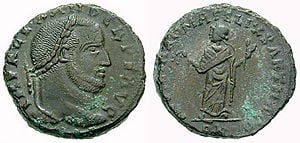
When Carthage fell, its nearby rival Utica, a Roman ally, was made capitol of the region and replaced Carthage as the leading center of Punic trade and leadership. It had the advantageous position of being situated on the Lake of Tunis and the outlet of the Majardah River, Tunisia's only river that flowed all year long. However, grain cultivation in the Tunisian mountains caused large amounts of silt to erode into the river. This silt was accumulated in the harbor until it was made useless, and Rome was forced to rebuild Carthage.
A new city of Carthage was built on the same land, and by the first century it had grown to the second largest city in the western half of the Roman Empire, with a peak population of 500,000. It was the center of the Roman province of Africa, which was a major "breadbasket" of the empire. Carthage briefly became the capital of an usurper, Domitius Alexander, in 308-311.
Carthage also became a center of early Christianity. Tertullian rhetorically addresses the Roman governor with the fact that the Christians of Carthage that just yesterday were few in number, now "have filled every place among you—cities, islands, fortresses, towns, market-places, the very camp, tribes, companies, palaces, senate, forum; we have left nothing to you but the temples of your gods." (Apologeticus written at Carthage, c. 197.) It is worth noting that Tertullian omits any mention of the surrounding countryside or its network of villas not unlike colonial hacienda society.
In the first of a string of rather poorly reported Councils at Carthage a few years later, no fewer than seventy bishops attended. Tertullian later broke with the mainstream that was represented more and more by the bishop of Rome, but a more serious rift among Christians was the Donatist controversy, which Augustine of Hippo spent much time and parchment arguing against. In 397 C.E. at the Council at Carthage, the Biblical canon for the western Church was confirmed.
The political fallout from the deep disaffection of African Christians was a crucial factor in the ease with which Carthage and the other centers were captured in the fifth century by Gaiseric, king of the Vandals, who defeated the Byzantine general Bonifacius and made the city his capital. Gaiseric was considered a heretic too, an Arian, and though Arians commonly despised Catholic Christians, a mere promise of toleration might have caused the city's population to accept him. After a failed attempt to recapture the city in the fifth century, the Byzantines finally subdued the Vandals in the sixth century. Using Gaiseric's grandson's deposal by a distant cousin, Gelimer, as a pretext, the Byzantines dispatched an army to conquer the Vandal kingdom. On Sunday, October 15, 533, the Byzantine general Belisarius, accompanied by his wife Antonina, made his formal entry into Carthage, sparing it a sack and a massacre.
During the emperor Maurice's reign, Carthage was made into an Exarchate, as was Ravenna in Italy. These two exarchates were the western bulwarks of Byzantium, all that remained of its power in the west. In the early seventh century, it was the Exarch of Carthage, Heraclius (of Armenian origin), who overthrew Emperor Phocas.
The Byzantine Exarchate was not, however, able to withstand the Arab conquerors of the seventh century. The first Arab assault on the Exarchate of Carthage was initiated from Egypt without much success in 647. A more protracted campaign lasted from 670-683. In 698 the Exarchate of Africa was finally overrun by Hassan Ibn al Numan and a force of 40,000 men, who destroyed Roman Carthage, just as the Romans had done in 146 B.C.E. Carthage was replaced by Tunis as the major regional center. The destruction of the Exarchate of Africa marked a permanent end to Roman or Byzantine influence there, as the rising tide of Islam shattered the empire.
Carthage today
Carthage remains a popular tourist attraction and residential suburb of Tunis, Tunisia, with a population of approximately 20,000.
Notes
- ↑ University of Leiden, Neo-Punic Texts. Retrieved May 23, 2007.
- ↑ Herodotus, V2. 165-167
- ↑ Polybius, World History: 1.7 - 1.60
- ↑ Adrian Goldsworthy, The Fall of Carthage (London & NY: Cassel, 2007, ISBN 0304366420).
- ↑ Susanna Shelby Brown, Late Carthaginian Child Sacrifice and Sacrificial Monuments in their Mediterranean Context (Sheffield Academic Press, 1992, ISBN 978-1850752400).
- ↑ Sergio Ribichini, "Beliefs and Religious Life" in Sabatino Moscati, (ed), The Pheonicians (I B Tauris & Co Ltd, 2001, ISBN 978-185043533), 141.
- ↑ Plutarch. Life of Pyrrhus. 22:1 - 22:3 Retrieved May 23, 2007.
- ↑ Plutarch. Life of Pyrrhus. Chapter 23 Retrieved May 23, 2007.
ReferencesISBN links support NWE through referral fees
- Aubet, María Eugenia. The Phoenicians and the West: Politics, Colonies and Trade. New York: Cambridge University Press, 2001. ISBN 0521795435
- Bath, Tony. Hannibal's Campaigns: the Story of One of the Greatest Military Commanders of All Time. Cambridge (Cambridgeshire): P. Stephens, 1981. ISBN 0850594928
- Beschaouch, Azedine. La légende de Carthage, Paris: Gallimard, 1993.
- Bonanno, Anthony. "Malta’s Role in the Phoenician, Greek, and Etruscan Trade in the Western Mediterranean." Melita Historica, 1999. Retrieved August 31, 2012.
- Broad, William J. "Phoenician Ship Wreck: Teaming up to find Ancient Mariners." New York Times, 1999.
- Brown, Susanna Shelby. Late Carthaginian Child Sacrifice and Sacrificial Monuments in their Mediterranean Context. Sheffield Academic Press, 1992. ISBN 978-1850752400
- Charles-Picard, Gilbert et Colette. La vie quotidienne à Carthage au temps d'Hannibal. Paris: Hachette, 1958.
- Decker, Roy A. "Economy of the Punic Phoenician Empire." Virtual Center for Phoenician Studies, 1999
- Decker, Roy A. "Carthaginians in the New World a radical theory." Virtual Center for Phoenician Studies, 1999. Retrieved August 31, 2012.
- Goldsworthy, Adrian. The Fall of Carthage. London & NY: Cassel, 2007. ISBN 0304366420
- Holst, Sanford. 2006. Phoenicians: Lebanon's Epic Heritage. Los Angeles, CA : Cambridge & Boston Press. ISBN 1887263306
- Khalaf, Salim. "Britain, Phoenicia’s Secret Treasure, and its Conversion to Christianity – the Legendary Tin Mines of Cornwall." Virtual Center for Phoenician Studies, 1999. Retrieved August 31, 2012.
- Khalaf, Salim. "Metals and Processees." Virtual Center for Phoenician Studies, 1999. Retrieved August 31, 2012.
- Khalaf, Salim. "Phoenician Trade and Ships." Virtual Center for Phoenician Studies, 1999. Retrieved August 31, 2012.
- Khalaf, Salim. "Phoenician Wine." Virtual Center for Phoenician Studies, 1999. Retrieved August 31, 2012.
- Khalaf, Salim. "Elissar Dido: Queen of Carthage." Virtual Center for Phoenician Studies, 1999. Retrieved August 31, 2012.
- Lipiński, Edward. Itineraria Phoenicia. Peeters Publishers, 2003. ISBN 9042913444
- Moscati, Sabatino (ed.). The Pheonicians. I B Tauris & Co Ltd, 2001. ISBN 978-1850435334
- Myers, Philip Van Ness. A General History for Colleges and High Schools. Boston, New York (etc.) Ginn & company, 1906.
- Serfaty, William. "The Pillars of the Phoenicians." Virtual Center for Phoenician Studies, 1997. Retrieved August 31, 2012.
- Soren, David, Ben Khader, Aicha Ben Abed, and Hédi Slim. Carthage: Uncovering the Mysteries and Splendors of Ancient Tunisia. New York: Simon and Schuster, 1990. ISBN 0671669028
- University of Chicago Polybius. Retrieved August 31, 2012.
External links
All links retrieved November 28, 2023.
Credits
New World Encyclopedia writers and editors rewrote and completed the Wikipedia article in accordance with New World Encyclopedia standards. This article abides by terms of the Creative Commons CC-by-sa 3.0 License (CC-by-sa), which may be used and disseminated with proper attribution. Credit is due under the terms of this license that can reference both the New World Encyclopedia contributors and the selfless volunteer contributors of the Wikimedia Foundation. To cite this article click here for a list of acceptable citing formats.The history of earlier contributions by wikipedians is accessible to researchers here:
The history of this article since it was imported to New World Encyclopedia:
Note: Some restrictions may apply to use of individual images which are separately licensed.
